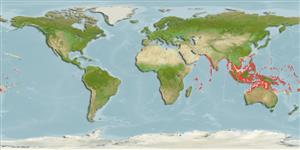Teleostei (teleosts) >
Beloniformes (Needle fishes) >
Hemiramphidae (Halfbeaks)
Etymology: Hemiramphus: Greek, hemi = half + Greek, rhamphos = bill, peak (Ref. 45335).
Environment: milieu / climate zone / depth range / distribution range
Ecology
Marine; reef-associated; depth range 0 - ? m. Tropical; 27°N - 23°S, 53°E - 157°W
Indo-Pacific: west coast of India and Sri Lanka (Ref. 6041) and from the Gulf of Thailand, Philippines, and East Indies eastward to New Guinea and western Polynesia.
Size / Weight / Age
Maturity: Lm ? range ? - ? cm
Max length : 34.0 cm TL male/unsexed; (Ref. 6041); max. published weight: 176.00 g (Ref. 125281)
Dorsal
spines
(total): 0;
Dorsal
soft rays
(total): 12-15;
Anal
spines: 0;
Anal
soft rays: 10 - 13. Greatly prolonged, beak-like lower jaw; upper jaw short, triangular and without scales; preorbital ridge absent; total number of gill rakers on first gill arch 25-32; dorsal fin without well-developed anterior lobe; pectoral fins short, not reaching past nasal pit when folded forward; no vertical bars on sides (Ref. 9843).
Inhabits the immediate vicinity of coasts, but juveniles may sometimes be found with floating plants carried out to sea. Taken with purse seines at Karwar on the west coast of India and with dol nets at Bombay. Marketed fresh and dried salted (Ref. 9843).
Life cycle and mating behavior
Maturity | Reproduction | Spawning | Eggs | Fecundity | Larvae
Collette, B.B., 1984. Hemiramphidae. In W. Fischer and G. Bianchi (eds.) FAO species identification sheets for fishery purposes. Western Indian Ocean (Fishing Area 51), Volume 2. FAO, Rome. (Ref. 6041)
IUCN Red List Status (Ref. 130435)
Threat to humans
Harmless
Human uses
Fisheries: commercial
More information
Common namesSynonymsMetabolismPredatorsEcotoxicologyReproductionMaturitySpawningSpawning aggregationFecundityEggsEgg development
ReferencesAquacultureAquaculture profileStrainsGeneticsElectrophoresesHeritabilityDiseasesProcessingNutrientsMass conversion
Tools
Can't connect to MySQL database fbquizv2. Errorcode: Too many connections
